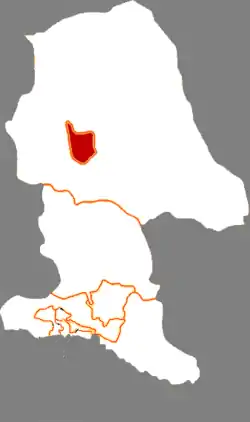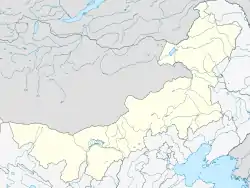Bayan Obo Mining District
Bayan'obo Mining District (Mongolian: ᠪᠠᠶᠠᠨ ᠣᠪᠣᠭ᠋ᠠ ᠠᠭᠤᠷᠬᠠᠢ ᠶᠢᠨ ᠲᠣᠭᠣᠷᠢᠭ, Chinese: 白云鄂博矿区), or Baiyun-Obo or Baiyun'ebo, is a mining district in the west of Inner Mongolia, China. It is under the administration of Baotou City, the downtown of which is more than 120 kilometres (75 mi) to the south.
Bayan'obo
白云鄂博矿区 • ᠪᠠᠶᠠᠨ ᠣᠪᠣᠭ᠋ᠠ ᠠᠭᠤᠷᠬᠠᠢ ᠶᠢᠨ ᠲᠣᠭᠣᠷᠢᠭ | |
|---|---|
 Bayan Obo, 2006 false color ASTER image by NASA | |
 Location in Baotou | |
 Bayan  Bayan | |
| Coordinates: 41°46′58″N 109°58′25″E | |
| Country | China |
| Autonomous region | Inner Mongolia |
| Prefecture-level city | Baotou |
| District seat | Tongyang Road Subdistrict |
| Area | |
| • Total | 247.89 km2 (95.71 sq mi) |
| Population (2020)[1] | |
| • Total | 22,681 |
| • Density | 91/km2 (240/sq mi) |
| Time zone | UTC+8 (China Standard) |
| Website | www |
| Bayan Obo Mining District | |||||||
|---|---|---|---|---|---|---|---|
| Chinese name | |||||||
| Simplified Chinese | 白云鄂博矿区 | ||||||
| Traditional Chinese | 白雲鄂博礦區 | ||||||
| Literal meaning | rich ovoo mining district | ||||||
| |||||||
| Mongolian name | |||||||
| Mongolian Cyrillic | Баян-Овоо Уурхайн дүүрэг | ||||||
| Mongolian script | ᠪᠠᠶᠠᠨ ᠣᠪᠣᠭ᠋ᠠ ᠠᠭᠤᠷᠬᠠᠢ ᠶᠢᠨ ᠲᠣᠭᠣᠷᠢᠭ | ||||||
| |||||||
The mines north of the town are the largest deposits of rare-earth elements yet found and, as of 2005, responsible for 45% of global rare-earth element production.[2][3][4]
In the satellite image at right, vegetation appears red, grassland is light brown, rocks are black, and water surfaces are green. Two circular open-pit mines are visible, as well as a number of tailings ponds and tailings piles.[5]
Administrative divisions
Bayan Obo Mining District is made up of 2 subdistricts.
| Name | Simplified Chinese | Hanyu Pinyin | Mongolian (Hudum Script) | Mongolian (Cyrillic) | Administrative division code |
|---|---|---|---|---|---|
| Subdistricts | |||||
| Mining Road Subdistrict | 矿山路街道 | Kuàngshānlù Jiēdào | ᠠᠭᠤᠷᠬᠠᠢ ᠵᠠᠮ ᠤᠨ ᠵᠡᠭᠡᠯᠢ ᠭᠤᠳᠤᠮᠵᠢ | Уурхай замын зээл гудамж | 150206001 |
| Tongyang Road Subdistrict | 通阳道街道 | Tōngyángdào Jiēdào | ᠲᠦᠩ ᠶᠠᠩ ᠵᠠᠮ ᠤᠨ ᠵᠡᠭᠡᠯᠢ ᠭᠤᠳᠤᠮᠵᠢ | Дүн ян замын зээл гудамж | 150206002 |
Climate
| Climate data for Bayan Obo (1991–2020 normals) | |||||||||||||
|---|---|---|---|---|---|---|---|---|---|---|---|---|---|
| Month | Jan | Feb | Mar | Apr | May | Jun | Jul | Aug | Sep | Oct | Nov | Dec | Year |
| Average high °C (°F) | −8.2 (17.2) |
−3.6 (25.5) |
3.8 (38.8) |
12.4 (54.3) |
19.1 (66.4) |
24.2 (75.6) |
26.5 (79.7) |
24.3 (75.7) |
18.7 (65.7) |
10.7 (51.3) |
0.9 (33.6) |
−6.8 (19.8) |
10.2 (50.3) |
| Daily mean °C (°F) | −14.3 (6.3) |
−10.2 (13.6) |
−2.9 (26.8) |
5.7 (42.3) |
12.7 (54.9) |
18.1 (64.6) |
20.6 (69.1) |
18.5 (65.3) |
12.4 (54.3) |
4.1 (39.4) |
−5.3 (22.5) |
−12.6 (9.3) |
3.9 (39.0) |
| Average low °C (°F) | −19.0 (−2.2) |
−15.2 (4.6) |
−8.4 (16.9) |
−0.5 (31.1) |
6.1 (43.0) |
12.0 (53.6) |
15.0 (59.0) |
13.2 (55.8) |
7.1 (44.8) |
−0.9 (30.4) |
−9.9 (14.2) |
−17.0 (1.4) |
−1.5 (29.4) |
| Average precipitation mm (inches) | 2.0 (0.08) |
2.6 (0.10) |
5.5 (0.22) |
6.5 (0.26) |
20.3 (0.80) |
34.6 (1.36) |
66.0 (2.60) |
58.0 (2.28) |
35.0 (1.38) |
10.3 (0.41) |
4.4 (0.17) |
2.0 (0.08) |
247.2 (9.74) |
| Average precipitation days (≥ 0.1 mm) | 3.6 | 3.3 | 4.4 | 3.1 | 5.6 | 9.3 | 11.6 | 9.6 | 6.9 | 3.5 | 3.9 | 3.4 | 68.2 |
| Average snowy days | 5.8 | 5.5 | 5.8 | 3.1 | 1.1 | 0 | 0 | 0 | 0.3 | 2.9 | 5.7 | 6.7 | 36.9 |
| Average relative humidity (%) | 63 | 54 | 42 | 34 | 37 | 45 | 53 | 56 | 54 | 50 | 58 | 63 | 51 |
| Mean monthly sunshine hours | 235.4 | 234.2 | 281.0 | 298.5 | 323.0 | 305.4 | 303.5 | 298.0 | 272.6 | 267.7 | 227.0 | 220.1 | 3,266.4 |
| Percent possible sunshine | 79 | 78 | 75 | 74 | 72 | 67 | 67 | 71 | 74 | 79 | 78 | 78 | 74 |
| Source: China Meteorological Administration[6][7] | |||||||||||||
Economic geology
China produced about 81,000 tons of rare-earth metals in 2001; the number jumped to about 120,000 by 2006. According to the Chinese Society of Rare Earths, 9,600 to 12,000 cubic metres (340,000 to 420,000 cubic feet) of waste gas—containing dust concentrate, hydrofluoric acid, sulfur dioxide, and sulfuric acid—are released with every ton of rare metals that are mined. Approximately 75 m3 (2,600 cu ft) of acidic wastewater, plus about a ton of radioactive waste residue are also produced.[5]
Mine deposit
Very large rare-earth elements (REE) Fe-Nb deposit (Bayan-Obo type), discovered as an iron deposit in 1927. REE minerals were discovered in 1936, and niobium-bearing ores in the late 1950s. Reserves are estimated at more than 40 million tons of REE minerals grading at 3–5.4% REE (70% of world's known REE reserves), 1 million tons of Nb2O5 and 470 million tons of iron. The deposit also contains an estimated 130 million tons of fluorite.
Bayan'obo is the world's largest known REE deposit.[8] The fluorite content of the ores also makes it the world's largest fluorite deposit.
The deposit occurs in an east–west trending Mesoproterozoic rift zone along the northern margin of the Sino-Korean Craton. Host strata are quartzite, slate, limestone, and dolomite. Dolomite is the main host rock. The orebodies are stratiform and lenticular, with masses, bands, layers, veins, and disseminations. Besides clear features of hydrothermal mineralization, the deposit also exhibits Mg, Fe, Na and F metasomatism. Sm-Nd monazite isochron age for bastnaesite and riebeckite is 1200 to 1300 Ma, whereas Th-Pb and Sm-Nd age of Ba-REE-F carbonates and aeschynite is 474 to 402 Ma.[9]
See also
References
- Inner Mongolia: Prefectures, Cities, Districts and Counties
- Lawrence J. Drewa, Meng Qingrunb and Sun Weijun (1990). "The Bayan Obo iron-rare-earth-niobium deposits, Inner Mongolia, China". Lithos. 26 (1–2): 43–65. doi:10.1016/0024-4937(90)90040-8.
- Xue-Ming Yang, Michael J. Le Bas (2004). "Chemical compositions of carbonate minerals from Bayan Obo, Inner Mongolia, China: implications for petrogenesis". Lithos. 72 (1–2): 97–116. doi:10.1016/j.lithos.2003.09.002.
- Chengyu Wu (2007). "Bayan Obo Controversy: Carbonatites versus Iron Oxide-Cu-Au-(REE-U)". Resource Geology. 58 (4): 348–354. doi:10.1111/j.1751-3928.2008.00069.x. Archived from the original on 2012-12-17.
- NASA Bayan Obo image and writeup
- 中国气象数据网 – WeatherBk Data (in Simplified Chinese). China Meteorological Administration. Retrieved 10 October 2023.
- 中国气象数据网 (in Simplified Chinese). China Meteorological Administration. Retrieved 10 October 2023.
- "Rare Earths: The Hidden Cost to Their Magic" (Part 2), Distillations Podcast and transcript, Episode 242". Science History Institute. June 25, 2019. Retrieved 28 August 2019.
- "Bayan Obo (Bayun-Obo; Baiyunebo) deposit, Bayan Obo, Darhan Muminggan United Banner, Baotou League, Inner Mongolia Autonomous Region, China". at Mindat.org
Further reading
- The Sedimentary Carbonate-Hosted Giant Bayan Obo REE-Fe-Nb Ore Deposit of Inner Mongolia, China: A Cornerstone Example for Giant Polymetallic Ore Deposits of Hydrothermal Origin, by E.C.T. Chao et al.. 1997, USGS Bulletin 2143. Full text online